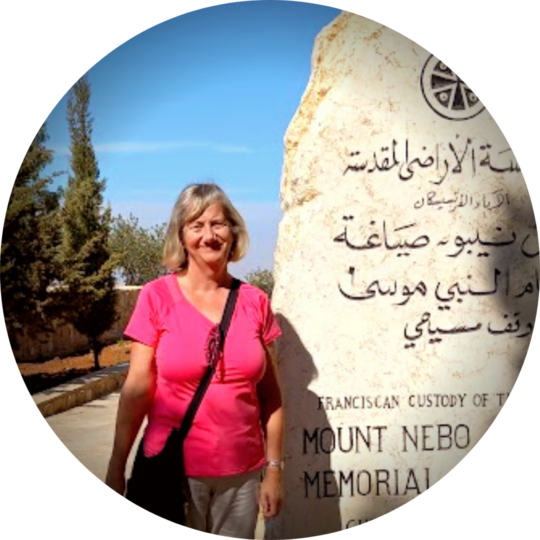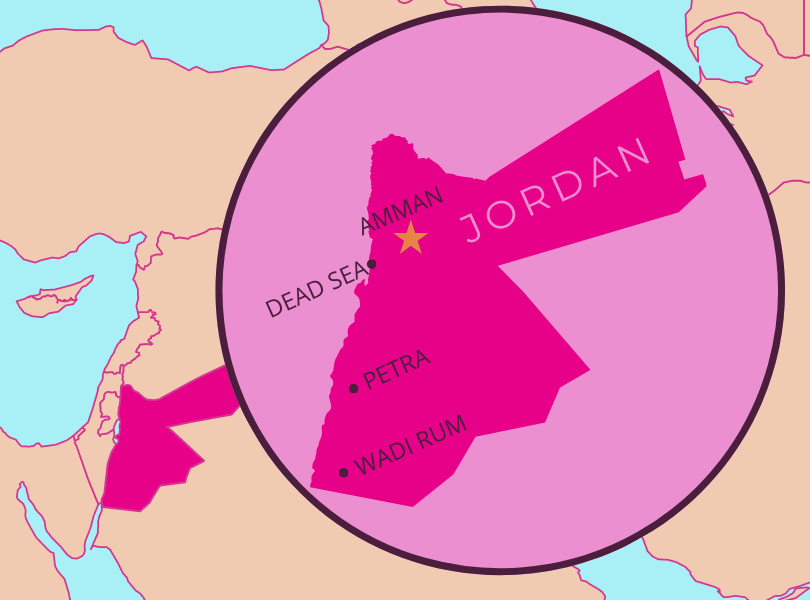


Jan’s holiday to Jordan
This summer, Jan and her family visited the middle east on a holiday in Jordan. They explored the city of Amman, stayed at a 5-star hotel on the shores of the Dead Sea, explored the ancient city of Petra carved into desert cliffs, and went on a jeep safari to visit petroglyphs at Wadi Rum.
Read on to hear more about Jan’s fantastic trip to Jordan. If you’re feeling inspired to book your own trip to Jordan, contact us and we can tailor a dream holiday just for you.
Contact us
Amman
Our holiday to Jordan was the trip of a lifetime. We had been dreaming for years of visiting this beautiful part of the world.
Our trip started in Amman, where we were delighted to find that the Queen Alia International Airport was clean, efficient and easy to navigate.
Since we were arriving late at night, we had organised a Meet and Assist service to greet us on arrival and help guide us through customs and transit. We were glad we did, as this really speeds up the process and was a huge benefit.
Amman is a very busy city with a population of 4 million. Public transport is very limited. To get around, we mostly used Uber, which was efficient and reasonably priced.
We did some walking as well and the locals were very helpful with directions. It is quite a hilly city. Rainbow Street is at the top of one of the hills. It is a vibrant and colourful street, well known for nightlife. It’s a great place to stroll and has some great cafes and restaurants, most of which have lovely views of the city.
The Jordan Museum is a must see. It was very well laid out and provides an interesting background to the history of Amman. It also contains some of the Dead Sea Scrolls.
Other highlights in Amman were the Roman Amphitheatre and the Citadel. The latter also has great views of the city, so it is good to arrive just before sunset.
The Dead Sea
The Dead Sea was the next stop on our holiday in Jordan. It’s about an hour’s drive from Amman to the Dead Sea, which is a large, very salty lake in the valley between Israel and Jordan. The lake is more than 400 metres below sea level, and its shores are the lowest land elevation in the world.
It’s called “dead” because the salty water is inhospitable to fish and other wildlife. It’s a very quiet and pristine lake, as there are no motor boats or other vehicles on the lake. One of the world’s first health resorts was on the Dead Sea.
Where we stayed at the Dead Sea
We stayed at the Kempinski Hotel, a 5-star hotel that has its own private beach.
The service at the Kempinski is second to none. There are 9 pools, 2 of which are infinity pools. It was an amazing feeling to swim in the infinity pools, with the views stretching across the sea. It is so nice to be relaxing at a pool and have an ice-cold washcloth handed to you to cool you down.
The food at the hotel is also excellent. We ate at the Lebanese restaurant one night and the second night at the restaurant beside the pool.
Jerusalem is only 35km away, just across the Dead Sea, and at night you can see the lights of Jerusalem twinkling on the far side of the water.
Swimming in the Dead Sea
Even if you are not staying at the Kempinski, it is possible to pay to access their private beach. It is well worth it as they have sun loungers, towels, water and even Crocs to wear as it can be quite rocky. Plus there’s a lifeguard on duty (yes, as easy as it is to float in the Dead Sea, accidents do happen, so it’s great to have that assurance).
It is hard to describe the sensation of swimming in the Dead Sea’s salt water. It’s the saltiest lake in the world — saltier than the oceans — and the salinity of the water is so high that you float effortlessly.
It is fun to see people’s reactions as they enter the water. The moment you enter the water, you feel lighter. Just a few metres in, it becomes impossible to stand — the salt water lifts you off the seafloor.
Just be careful not to get your face in the water, as salt in the eyes will burn like crazy. It’s also important not to stay in the water too long. There is a large clock displayed by the sea as you should not be in the water for more than 10 minutes.
When you come out of the water you can cover yourself with Dead Sea mud and let it dry. Because of all the minerals in the Dead Sea, the mud is great for your skin and has a moisturising effect. Think of what you’d pay for that mud at a spa!
Once the mud is dry you can wash it off in the sea and then the showers that are available. There’s even a full-length mirror in case you miss a bit! I have to say I did find my skin nice and smooth afterwards.
Petra
A holiday to Jordan would not be complete without a visit to the ancient city of Petra. It’s about a 2.5 hour drive from the Dead Sea to Petra.
Petra was built over two thousand years ago, with buildings carved into the cliffs of the desert. It was part of a major trade route connecting ancient Mesopotamia and Egypt and is now a UNESCO world heritage site.
Petra is known as the Rose-Red City, a name it gets from the wonderful colour of the rock into which many of the city’s structures were carved. Photos don’t do it justice as the buildings are so huge it is amazing to think of the workers who climbed up the rocks and carve all the structures.
The Treasury is probably the most photographed structure. It’s the first building you see when you approach Petra via a trail through a narrow canyon. The Treasury is 40 meters high and intricately decorated.
It takes hours to wander around Petra. In fact, some people take more than a day to see everything. It is a long walk from the entrance through the city, but there are golf carts for rent for those unable to walk long distances.
We walked it twice, as we went to Petra by night and then again first thing the next morning. It was a lovely atmosphere walking in at night — it is all lit up by thousands of candles and it is possible to imagine what it was like all those years ago. The Petra by night experience also includes a musical performance, although we didn’t find the actual music show to be very entertaining, so I am not sure it is worth the hefty entrance fee.
Wadi Rum
Next, we headed off to Wadi Rum in the Arab Saharan Desert further south. The Jordanian tourist board describes the ‘Valley of the Moon’ as one of the most spectacular desert landscapes on earth and I found this to be true.
Wadi Rum is an open desert of canyons, rock and sand. There are almost zero buildings, and its inhabitants are the same Bedouin tribes who have lived here throughout history. Wadi Rum offers incredible landscapes, jeep safaris, Bedouin hospitality, and activities like hiking, rock climbing, ATV, and hot air ballooning.
We did experience a jeep safari – not for the faint-hearted, but it gave us a chance to see the petroglyphs, the amazing rock formations and the amazing feeling of being in such a remote and beautiful landscape.
We stayed overnight in the Wadi Rum Oasis Camp in one of their bubble tents, which was extremely comfortable. Dinner was delicious lamb and chicken that had been slowly cooked in a fire pit along with lots of vegetables. The flatbread which was cooked over a fire by one of the staff was also to die for.
Madaba
It is possible to go to the Red Sea from Wadi Rum as it is very close, and I have heard that the scuba diving and snorkelling are wonderful.
However, we had our flight booked back from Amman so we headed back the next morning. It takes about 5 hours to Amman from Wadi Rum.
Along the way, we stopped in Madaba, which is close to Amman and is known for the fascinating mosaic in St. George’s Byzantine Church. The mosaic dates back to the 6th century AD and depicts an area from Lebanon to the Nile Delta, and from the Mediterranean Sea to the Eastern Desert.
It is the oldest known geographic floor mosaic in art history. There is a great explanation of the mosaic at the church, and it is wonderful to see all the names of the places from that time in history and what still remains today. I particularly loved the depiction of a fish warning another fish not to enter the Dead Sea as he would die!
From Madaba it is a short distance to Mount Nebo, which is reputed to be the burial place of Moses and also where he was shown the Promised Land. The view of the green, lush Jordan valley is spectacular, and you can see why it’s considered a sacred place. It is a very peaceful area and lovely to walk around.
If you’re inspired by Jan’s holiday to Jordan and would like to experience this fantastic destination for yourself, get in touch with our team.
We can create an itinerary just for you.
Call us at 01 833 3921 or share some details and our team will be in touch soon:




































